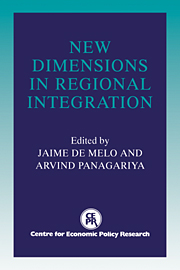Book contents
- Frontmatter
- Contents
- List of figures
- List of tables
- Preface
- Foreword
- Acknowledgements
- List of conference participants
- PART ONE SYSTEMIC ISSUES
- 1 Introduction
- 2 Regionalism and multilateralism: an overview
- Discussion
- 3 Regionalism versus multilateralism: analytical notes
- Discussion
- 4 Multilateral and bilateral trade policies in the world trading system: an historical perspective
- Discussion
- 5 GATT's influence on regional arrangements
- Discussion
- PART TWO COUNTRY ISSUES
- Index
Discussion
Published online by Cambridge University Press: 04 May 2010
- Frontmatter
- Contents
- List of figures
- List of tables
- Preface
- Foreword
- Acknowledgements
- List of conference participants
- PART ONE SYSTEMIC ISSUES
- 1 Introduction
- 2 Regionalism and multilateralism: an overview
- Discussion
- 3 Regionalism versus multilateralism: analytical notes
- Discussion
- 4 Multilateral and bilateral trade policies in the world trading system: an historical perspective
- Discussion
- 5 GATT's influence on regional arrangements
- Discussion
- PART TWO COUNTRY ISSUES
- Index
Summary
In this Discussion, I shall not contradict anything Finger says in his Chapter 5; I will rather try to build on it and make a few complementary remarks.
Of the numerous regional or, as I prefer to call them, limitedmembership, trade agreements concluded since World War II, the Euro pean Community alone fully met the formal requirements of GATT Article XXIV; yet none of the others were held up by GATT. These other agreements fall into the following categories:
The quasi-Community agreements: these bind to each other and to the EC members of the European Free Trade Area (EFTA). These countries generally trade more with the Community than with each other, have effectively eliminated their merchandise trade barriers towards the Community and towards each other in everything but agriculture, and are relatively free traders toward the rest of the world.
The peri-Community agreements between the Community and developing countries of the (Asia, Pacific and Caribbean) ACP group, of the Mediterranean, and more recently of East Europe. These give free or almost free access to EC markets for non-agricultural goods, and varying degrees of preferential access for agricultural goods. These preferences are applied de facto unilaterally for the ACP group, and with various degrees of asymmetry for the others.
Finally, from the Montevideo Treaty through ASEAN, a host of preferential trading arrangements among developing countries where neither trade nor preferences usually amount to much.
Finger waxes slightly indignant that GATT has never done anything to stop these arrangements. I wish to point to another aspect of GATT's role.
- Type
- Chapter
- Information
- New Dimensions in Regional Integration , pp. 148 - 156Publisher: Cambridge University PressPrint publication year: 1993

